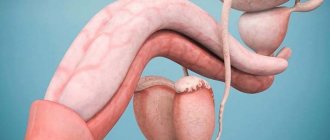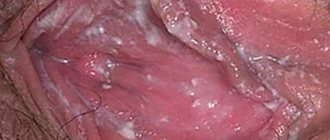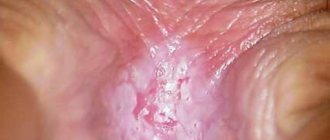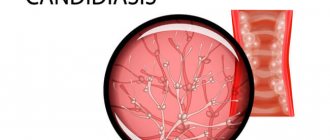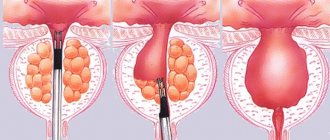- Features of candidiasis in men and women
- Symptoms of thrush
- Causes
- How to prevent the development of thrush
- Diagnosis and treatment
- Rules to follow during treatment
- Complications
Candidiasis - or thrush - is a disease caused by a fungal infection.
Fungi of the genus Candida - microorganisms that provoke the disease - belong to the opportunistic flora. If there is no active reproduction, their presence in the body is normal. Thrush manifests itself when a colony of fungus actively grows on the mucous membranes. For quick and effective treatment of the disease in men, there are a number of topical medications, as well as antifungal medications for oral administration.
Features of candidiasis in men and women
Stereotypes imposed by the media and advertising lead many to consider thrush to be a female disease only. However, this is far from true: men also experience candidiasis, although much less frequently.
According to statistics, 3 out of 4 women under 25 have encountered this problem at least once, and every second woman who has had the disease experiences relapses. The lower prevalence of the disease among men is due to the structure of the genital organs.
40% of men are carriers of bacterial infection. Microorganisms are present in minimal quantities and practically do not cause harm to health. The fungus begins to manifest itself during periods of a sharp weakening of the immune system, stress or overwork.
Fungi of the genus Candida are located in the intestines, mouth, and genitals.
TREATMENT FOR THRUST IS AVAILABLE AT THE BRANCHES:
Treatment of thrush in the Primorsky region
Address: St. Petersburg , Primorsky district, st. Repisheva, 13
Treatment of thrush in the Petrograd region
Address: St. Petersburg , Petrogradsky district, st. Lenina, 5
Treatment of thrush in Vsevolozhsk
Address: Vsevolozhsk , Oktyabrsky Prospekt, 96 A
Symptoms of thrush
Unlike women, men do not notice the disease immediately. The onset of the disease is asymptomatic. Over time, the skin of the penis affected by the fungus turns red, and the inner part of the foreskin may swell.
After a few days, itching and burning appear, which spread to the scrotum and groin area. Unpleasant sensations intensify when urinating or during sexual intercourse. A cheesy discharge that has an unpleasant odor may appear under the foreskin.
The disease often provokes swelling of the penis, inflammation of the urethra and the appearance of a gray-white coating. It is not recommended to remove it yourself, so as not to provoke an exacerbation of inflammation.
Rashes appear on the head of the penis - bubbles with liquid, which later turn into erosion. Due to drying of the skin, cracking occurs.
Causes
The appearance of a fungal infection is usually caused by weakened immunity and stress. Bad habits aggravate the situation: excessive alcohol consumption, smoking. Due to a decrease in the protective function, the body cannot cope with maintaining a safe amount of fungal forms, and they enter the phase of active reproduction.
External causes include hypothermia, which also contributes to a decrease in immunity. Therefore, candidiasis can develop against the background of a common cold.
Unprotected sexual intercourse also provokes the active development of infection. Candidiasis itself is not transmitted from partner to partner, but during sex without barrier contraceptives (condoms), fungal microorganisms are exchanged. Usually they do not take root, but if the immunity of one of the partners is weak, the fungi survive, which leads to the development of the disease.
In addition, unprotected sex leads to the risk of contracting STDs, which greatly affect the body's protective properties and can become an additional reason for the active proliferation of Candida fungi.
Risk factors for development
The likelihood of infection increases with casual sexual intercourse, uncontrolled use of antibiotics and drugs that disrupt the natural microflora. Foods with large amounts of sugar and carbohydrates create a favorable environment for fungal growth. Excessive sweating also leads to an exacerbation of candidiasis, so it is necessary to wear cotton underwear that allows the skin to breathe and moisture to evaporate.
At the same time, excessive cleanliness can also cause harm. We are talking about douching. It should not be used as a method of contraception, since it is not effective, and also as a means of hygiene, because it leads to the leaching of the protective flora. If you experience discomfort, you should first consult a doctor.
How to prevent the development of thrush
Prevention of thrush in men does not require special measures and comes down to the usual rules of intimate hygiene.
To prevent the spread of the fungus, it is necessary to carefully monitor the cleanliness of the genitals:
- regularly wash the head of the penis with warm water without soap (morning and evening);
- it is advisable to rinse the head of the penis with warm water after each urination;
- thoroughly wash the entire groin area to prevent the formation of prickly heat;
- wear comfortable underwear made from natural fabrics;
- change linen regularly;
- do not wear too tight trousers, especially in hot weather;
- do not touch the genitals with dirty hands; before urinating, it is advisable to wash your hands with soap.
The issue of contraception plays a special role in prevention. During casual sexual intercourse, be sure to use a condom to prevent infection with fungal infections and STDs.
It is necessary to use a condom during oral and anal sex: the microflora of the intestines and oral cavity is pathogenic, and unprotected contacts of this kind lead to a number of diseases.
Contact with a regular partner may be unprotected or using other methods of contraception. In this case, you should make sure that both are in good health, or get examined by a doctor.
Important: compliance with safety measures will eliminate the development of thrush by almost 100%.
What will happen if left untreated?
There are short-term and long-term consequences of candidiasis in men. Relatives that manifest themselves already during the acute course of the disease include:
- predisposition to sexually transmitted diseases due to damage to the mucous membranes (erosion, cracks) of the genital organs, through which infection easily penetrates;
- erosions on the mucous membrane of the genital organs, accompanied by pain and causing problems in intimate life.
Long-term consequences of thrush include:
- prostatitis - inflammation of the prostate gland;
- cystitis - inflammation of the bladder;
- nephritis, pyelonephritis, glomerulonephritis - inflammation of kidney tissue;
- diseases of the ovaries, ducts, problems with reproduction (infertility in men and women);
- urethral syndrome (urethritis) is a pathological inflammatory process in the urethra.
Diagnosis and treatment
Thrush can be identified by the main symptoms of the disease, but a similar clinical picture is observed in other diseases, so only a doctor can make a final diagnosis.
Important: thrush does not go away on its own; the disease must be treated.
To make a diagnosis, laboratory – bacteriological and microscopic – studies are carried out. After deciphering the test results, the doctor prescribes a course of antifungal therapy.
The basis for diagnosis is the presence of fungal elements in the collected biomaterial. Bacteriological culture analysis allows you to determine the type and genus of fungi. This is necessary in order to correctly select antimycotic (antifungal) drugs.
Typically, topical medications are prescribed for treatment - creams and ointments that suppress pathogenic microorganisms. If such therapy is ineffective, the doctor prescribes general medications.
Fluconazole
- Active against Candida fungus;
- Indicated for vaginal candidiasis, cryptococcal meningitis, coccidioidomycosis, invasive candidiasis;
- Indicated for mucous candidiasis, dermatomycosis, dermatophytosis of the nails.
More details
THERE ARE CONTRAINDICATIONS. BEFORE USE, READ THE INSTRUCTIONS CAREFULLY OR CONSULT A DOCTOR
Candidiasis
Cervical cancer
Diabetes
HIV
Thrush
18330 27 July
IMPORTANT!
The information in this section cannot be used for self-diagnosis and self-treatment.
In case of pain or other exacerbation of the disease, diagnostic tests should be prescribed only by the attending physician. To make a diagnosis and properly prescribe treatment, you should contact your doctor. Candidiasis: causes, symptoms, diagnosis and treatment methods.
Candidiasis is an infectious disease caused by yeast-like fungi of the genus Candida. It is caused by the active proliferation of fungus on the mucous membranes of the oral cavity, genital and internal organs and on the skin.
All representatives of the genus Candida belong to opportunistic microorganisms, that is, they are constantly present in the normal microflora. But with a decrease in immunity, changes in hormonal levels and for a number of other reasons, these fungi can begin to actively colonize the mucous membranes and skin.
The most common members of the genus are Candida albicans and C. tropicalis. In 90-95% of cases of urogenital candidiasis, C. albicans is the dominant pathogen.
The first contact with fungi of the genus Candida occurs during the passage of the child through the birth canal. However, the medical literature describes cases of detection of these microorganisms in amniotic fluid, which indicates the possibility of a vertical (transplacental) transmission route. Transmission of the fungus of the genus Candida also occurs through breastfeeding, skin contact between the child and the mother, and through household and food routes.
These microorganisms produce endotoxins and enzymes that cause cell death and tissue necrosis, which enhances the adhesive (attachment to cells of the mucous membranes or skin) ability of the fungus and ensures penetration into tissue.
Overproduction of these and a number of other substances determines the pathogenicity of representatives of the Candida family.
Causes of candidiasis
- Exogenous (external) factors facilitating the penetration of fungi into the body:
- occupational hazards leading to frequent skin damage;
- prolonged exposure to a warm and humid environment;
- violation of the integrity of the mucous membranes.
- Factors leading to a decrease in the body's resistance:
- presence of chronic diseases;
- long-term use of drugs that disrupt the natural microflora;
- unbalanced diet;
- frequent stress, disturbances in sleep and rest patterns.
Risk factors for developing candidiasis
- Metabolic disorders (hypovitaminosis), diseases of the immune system (HIV infection), endocrine pathologies (diabetes mellitus, etc.).
- Long-term use of certain drugs: hormonal contraceptives, systemic glucocorticosteroids, broad-spectrum antibiotics, cytostatics.
- Long stay or living in an area with high humidity and temperature, comfortable for the circulation of fungal spores in the environment.
Classification of the disease
Based on the localization of the process, the following are distinguished:
- Urogenital candidiasis.
- Candidiasis of the oral mucosa.
- Superficial candidiasis.
- Interdigital candidiasis.
- Candidiasis of periungual ridges and nails.
- Candidiasis of the gastrointestinal tract.
Symptoms of candidiasis
Urogenital candidiasis (UGC)
– a widespread disease: according to medical statistics, about 75% of women of reproductive age have registered symptoms of UGC at least once.
There are acute and chronic forms of urogenital candidiasis, candidiasis of the vulva, vagina and other urogenital localizations.
In some cases, when diagnosing, a clarification is used: complicated or uncomplicated UGC, which reflects the number of exacerbations per year and the severity of the disease. Symptoms of female urogenital candidiasis
- The appearance of white-yellow cheesy or creamy discharge from the genital tract. The intensity of discharge may increase before menstruation, which is associated with changes in hormonal levels.
- Unpleasant sensations, itching in the genital area, often aggravated by sexual intercourse or urination.
- Redness and swelling of the mucous membrane of the vulva and vagina, the presence of damage to the skin of the genital organs (cracks, microtraumas).
- In the chronic course of UGC, dryness of the mucous membranes of the genital tract develops.
Symptoms of male urogenital candidiasis
- Redness, swelling, discomfort in the genital area.
- Whitish discharge of a cheesy structure from the genital tract.
- Pain and burning during sexual intercourse and urination.
Superficial candidiasis
can be erythematous (the main symptom is reddened areas of the skin with a weeping surface) and vesicular (the formation of papules, vesicles and pustules in the affected area - inflammatory elements located in the superficial layers of the skin). The lesion begins with large folds of skin, gradually spreading to other areas of the body. In the depths of the folds, weeping occurs (separation of serous exudate through the smallest defects of the epidermis), a violation of the integrity of the skin contributes to the addition of a secondary infection.
Interdigital candidiasis
localized in the space between the fingers. In this case, redness of the skin is noted, followed by the appearance of bubbles in transparent contents. The disease spreads quickly in close groups (in kindergartens, schools, etc.).
Oral mucosal candidiasis (OCOR)
Oral candidiasis causes discomfort, especially when eating - burning, pain, dryness. Depending on the location of the process, several forms of oral candidiasis are distinguished.
Often, CSOPR and the gastrointestinal tract accompanies immunodeficiency conditions: HIV infection, acquired human immunodeficiency syndrome (AIDS) or congenital immunodeficiency (for example, with T-lymphocyte pathology). In the presence of these diseases, candidiasis occurs with the most severe symptoms, is difficult to treat, and is aggressive in nature.
The most common manifestation of CSOPR is candidal stomatitis, which mainly affects infants and adults with weakened immune systems.
With this pathology, the oral mucosa turns red, swells, and whitish films with a cheesy consistency appear on it. In the initial stages of the disease, plaque is easily removed. As the disease progresses, the films become denser, are difficult to separate, and when removed, the bleeding mucous membrane is exposed.
With candidal stomatitis, the tongue may be affected, which is manifested by redness of the back of the tongue, the appearance of plaque and desquamation of the epithelium. These symptoms are accompanied by severe pain in the affected area when talking, eating, and palpating the tongue.
Smokers, more often than other types of CSOPR, develop chronic hyperplastic candidiasis, accompanied by the formation of white, merging plaques that rise above the surface of the hyperemic mucosa.
With this pathology, the consistency of saliva changes: it becomes viscous and foaming; there is an unpleasant odor from the mouth, a gray or white coating on the mucous membrane. In 10-40% of cases, this clinical form of candidiasis becomes malignant (i.e., becomes malignant).
Older people most often develop a chronic atrophic form of oral candidiasis. The mucous membrane turns red and swells. The lesion is often localized under dentures, which causes pain.
Candidal cheilitis and candidiasis of the corners of the mouth mainly occur in children and the elderly. The lesion is usually bilateral, with the formation of red, painful cracks in the corners of the mouth, covered with an easily removable white coating or scales. With a long course of the disease, a bacterial infection may occur.
Diagnosis of candidiasis
The diagnostic search algorithm for candidiasis of any localization includes taking material from the affected area, followed by microscopy and culture to determine the type of fungus and its sensitivity to antimycotic (antifungal) drugs.
In order to diagnose conditions that lead to a decrease in immunity, a general blood test is used;
Rules to follow during treatment
During the therapy period, it is necessary to avoid sexual intercourse so as not to provoke the development of the disease. If possible, you should stop smoking and not drink alcoholic beverages. Avoid hypothermia and stress.
To reduce symptoms, it is recommended to choose loose underwear and clothing, and ensure that the groin area remains dry.
Nutrition:
- Eliminate sugar, fast carbohydrates, yeast and other fermentation products: they contribute to the development of fungal forms.
- Add fermented milk products with live cultures, whole grains, fresh and thermally processed vegetables and fruits to your diet.
Compliance with the diet will strengthen the body's protective functions and shorten the period of the disease, and the formation of healthy eating habits will eliminate the risk of relapse.
Complications
Lack of timely treatment can lead to disruption of the structure of the urethral mucosa, which will complicate the process of urination. The long course of the disease reduces the sensitivity of nerve endings, which leads to loss of pleasure from sexual intercourse. It is much more difficult for a man to achieve orgasm, against the background of which libido disappears and sexual dysfunction may develop.
To avoid consequences, you should consult a doctor immediately after detecting symptoms of candidiasis and follow the treatment recommendations prescribed by a specialist.
Important: traditional methods are extremely ineffective in treating fungal infections. Neglecting the methods of official medicine aggravates the course of the disease and leads to the development of complications.
Factors that contribute to the disease
The most common causes of urogenital candidiasis are:
- weakened immune system;
- existing endocrine disorders (sharp weight gain, diabetes mellitus, thyrotoxicosis, etc.);
- neglect of personal hygiene rules;
- inflammatory diseases of the genitourinary system;
- use of spermicidal, intrauterine contraceptives;
- wearing tight synthetic underwear;
- use of hygienic douches;
- uncontrolled use of antibiotics, in particular intravaginal ones (in the form of capsules, creams, suppositories);
- prolonged use of sanitary pads that have little or no air permeability;
- long-term treatment with corticosteroid hormones, immunosuppressants, cytostatics.
Sometimes a woman does not have any factors conducive to infection, but against the background of stress and hormonal imbalance, she is diagnosed with persistent recurrent thrush. In such a situation, individual congenital pathologies are analyzed that affect changes in the vaginal epithelium, causing a failure of the mechanisms of the local immune response.
